| dc.description.abstract | Acid jetting is a well stimulation technique that is used in carbonate reservoirs. It typically involves injecting acid down hole at high flow rates through small orifices which cause high velocities of acid to strike the borehole wall. The combination of high kinetic energy and chemical reaction of the acid removes drilling mud filter cake from the borehole wall and produces long conductive channels, called wormholes, into the formation, therefore improving well performance.
Studies have shown that injecting fluid down hole at high velocities can mitigate damage to wellbore caused by drilling mud filter cake. Both water and acid have shown positive results in such cases. However, there are no laboratory results on how high velocity acid impacts the borehole wall and the formation of wormholes. The purpose of this study is to investigate how the high velocity acid affects the acidizing treatments. The experiments are conducted on 4” diameter by 16” length Indiana limestone cores with acid injected at the velocity of 106 ft/s, 150 ft/s, and 200 ft/s. The experiments are conducted with a constant pressure differential across the core. 15%wt Hydrochloric acid is injected at room temperature at various flux rates.
The results show that the higher the velocity of jetted acid, the further it penetrates into the formation. The 200 ft/s acid penetrates furthest into the core, thus potentially lowering the skin factor the greatest. A large cavity is formed into the core from the high velocity acid. This large cavity creates a pathway for acid to divert into the core to create wormholes. Acid jetting cannot be directly compared with matrix acidizing because of the formation of these large cavities. The Buijse-Glasbergen model that is used to predict the formation of wormholes does not accurately match the acid jetting data due to the formation of these large cavities, so the optimum flux and pore volume to breakthrough cannot be accurately determined. | en |


